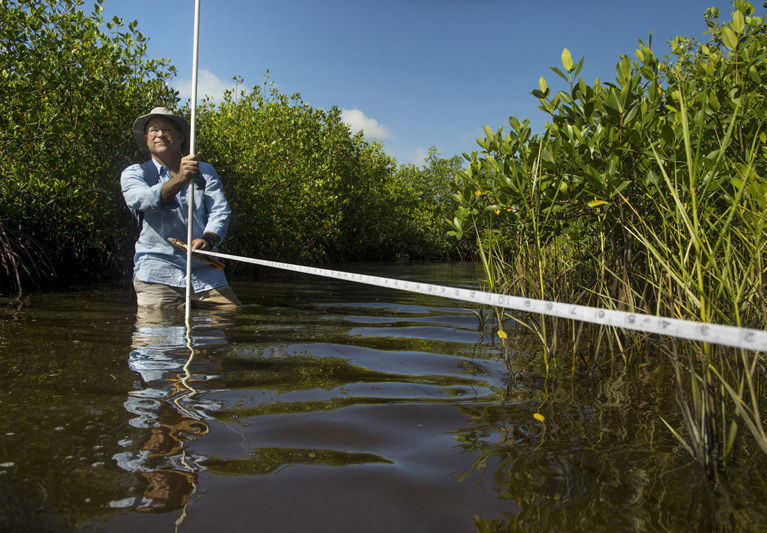
INDIAN RIVER COUNTY — There’s a lot going on at the Indian River Land Trust, the respected Vero Beach nonprofit that saved eight miles of green lagoon shoreline from development over the past five years.
Over the summer the Trust picked up two more key pieces of lagoon-side land, hired an impressive new director of land protection and established an endowment to help fund stewardship of its holdings.
The new hire and the endowment signal a fundamental shift in the Trust’s mission, as it widens its focus from mere land acquisition to the ecological rehabilitation of existing properties.
“Land acquisition continues to be a primary focus of the Land Trust,” says island resident David Heuberger, who started as director of land protection on Aug. 3. “But we will be putting more emphasis on stewardship. A lot of the Land Trust properties have the potential for restoration of their biological processes and their interrelationship between upland watersheds and the Indian River lagoon.”
“To that end, the board put its money where its mouth is and built an endowment for stewardship,” says Ann Taylor, director of marketing and philanthropy. “It is about $800,000 today and will be used first for daily expenses as David and his team work with the board to create management plans and come up with restoration priorities. As projects are identified, we believe the endowment will grow to cover the costs of implementing the projects.”
“As you know, we have been acquiring property for five years to protect as much as we can of the remaining undeveloped land along the river,” says Land Trust Executive Director Ken Grudens. “We are still looking to acquire new pieces to complete the puzzle of important waterfront land, but we have also come to realize our responsibility and need to manage the lands we have to optimize biological diversity and productivity and restore the natural function of the wetlands as buffers that protect water quality in the lagoon.”
The Trust closed on two parcels in July, increasing its conservation holdings along the lagoon to 900 acres.
A 25-acre piece of ecologically significant property adjacent to 150 acres the Trust already owns north of the Barber Bridge was picked up at a bargain in a tax auction.
“We were able to buy that through the tax lien deed process,” Grudens says. “It was a leftover piece form the Riverwind development property and taxes were four years in arrears. Once we acquired the liens, it set forth a process to bring the property to a taxing auction. There were no other bidders, so we were able to acquire the 25 acres for $24,000.
“It is an important piece because it is interconnected with the larger piece that has been restored to a natural state and impacts on it.”
Another 30 acres were acquired in the Tony Robbins Waterfront Trail area near Hobart Landing by means of a complex three-way transaction.
Members of the Hobart family bought the property 15 years ago and deeded it to a national nonprofit to keep it from being developed, according to Grudens. The nonprofit later deeded the land to St. Johns River Water Management District.
All was well until a couple of years ago when St. Johns announced it was going to sell some of its massive and holdings as surplus to the highest bidder.
“Members of the Hobart family were in here to talk to us right after St. Johns announced its intention to surplus the land,” says Taylor. “The Hobart Landing community was very concerned.”
St. Johns wasn’t allowed to convey the land to a private entity such as the Land Trust, but it could give the property to the county if it wanted to. Working with St. Johns and the county commission, the Land Trust engineered a three-way transaction in which the land passed through the county’s hands and then was deeded to the Trust.
“We paid some funding consideration for the carrying costs St. Johns incurred over the years, but the amount was a fraction of market value,” Grudens says. “So now we have a total of about 40 acres of contiguous conservation land at the Tony Robbins Trail. The community is very pleased.”
Some of the Land Trust’s holdings, such as the Robbins Trail property, are managed for public access as well as conservation and lagoon restoration. Other properties are open only by special tours.
The Indian River Land Trust has a staff of six that is strongly backed by a 25-member board of directors.
It started developing land management plans prior to hiring Heuberger. Vero Beach ecologist David Cox was hired to create scientific restoration plans for six properties, including Bee Gum Point. He says three plans are complete and the other three will be done by November.
But Heuberger and the new endowment bring a dedicated emphasis to stewardship within the organization. Heuberger is in the early stages of developing management plans for eight properties.
Coastal wetlands have long served as the nursery of the oceans, the shifting tidal environment where fish hatch and mature before braving the open waters of the lagoon or the Atlantic. But the wetlands have lost much of their biological diversity and productivity, and much of their ability to filter polluted water, because of impoundments that cut them off from the natural ebb and flow and other types of degradation.



